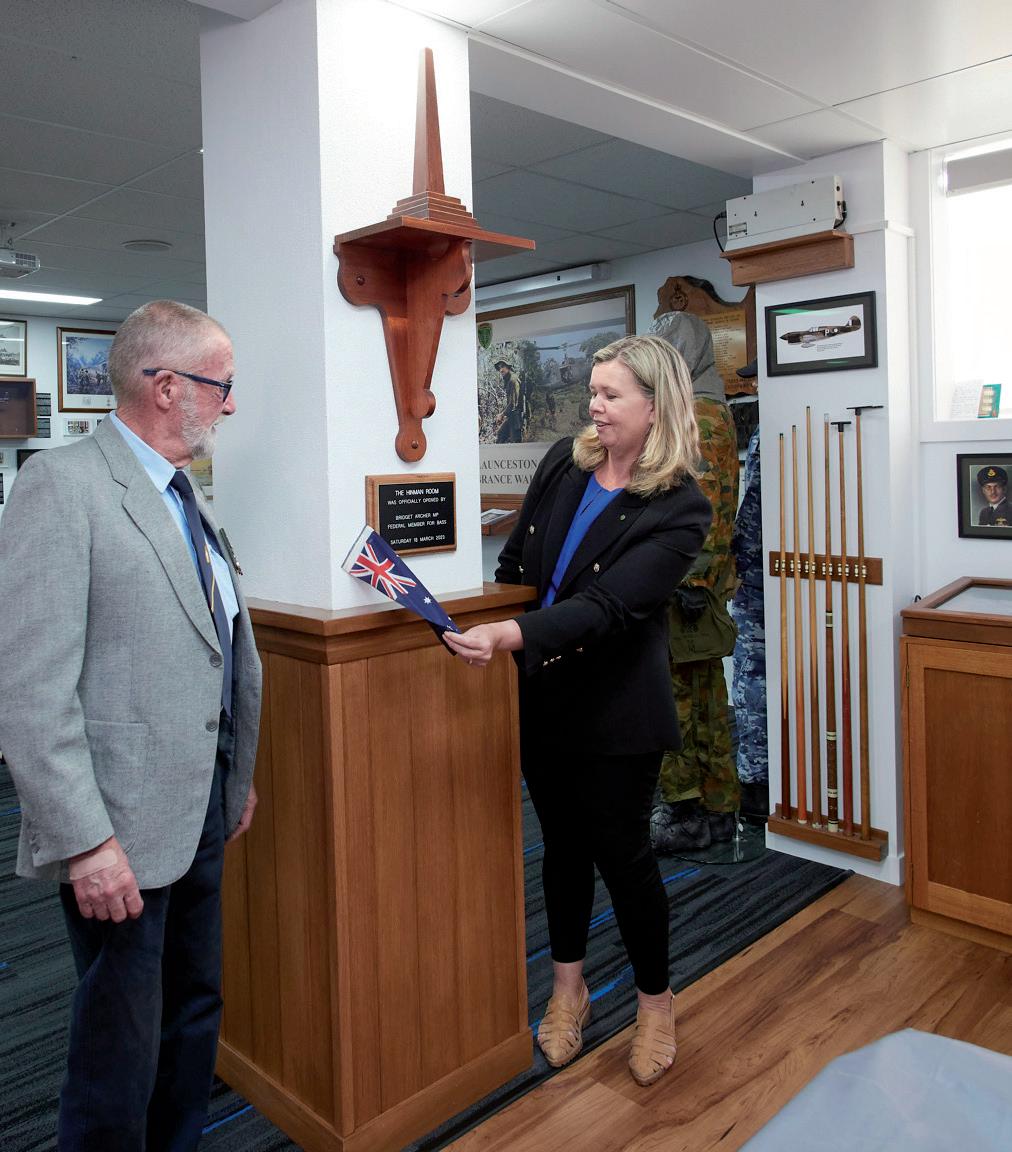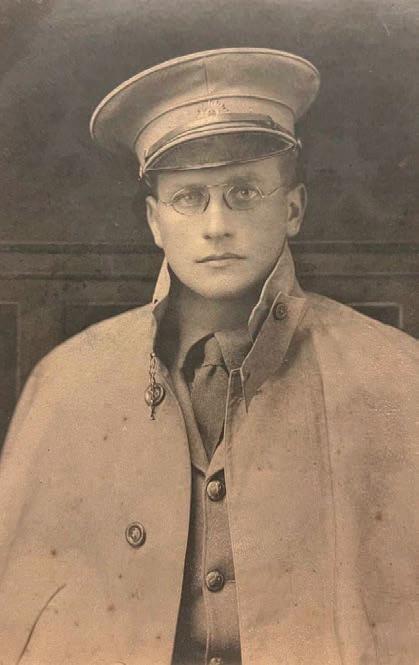
8 minute read
The story behind the Hinman Room
The Launceston RSL has recently undergone a significant upgrade and refurbishment, with the last stage of the upgrades, the Hinman Room, named after World War One soldier, Arthur Gurr Hinman.
The room was officially unveiled recently in front of RSL members, supporters and family of Mr Hinman, who was shot and killed at Gallipoli on May 10, 1915.
Advertisement
In the years after his death, Mr Hinman’s family donated a snooker table in his honour to the Launceston RSL, which was the beginning of a long relationship between the family and the RSL which continues to this day.
Federal Member for Bass Bridget Archer who secured the $250,000 funding needed to undertake the upgrades, shared the following story of Arthur Hinman during the official unveiling:
“Arthur was born on June 19, 1890, the second son of Arthur and Lucy Maud Hinman. He was educated at Launceston Church Grammar School before leaving the state to enrol in a Bachelor of Mining Engineering course at the University of Melbourne in 1909.
Juggling his studies with a love of football, he made his VFL debut in 1910, enjoying a 24-game career with the University Football Club as wingman before eventually leaving behind his VFL career to concentrate on his degree. Upon graduation, Arthur returned to Tasmania where he lived in Waratah while working for the Mount Bischoff Tin Mining Company.
When the war broke out in August of 1914, Hinman immediately enlisted, joining the 15th Battalion 1st AIF, leaving Australia on November 30 of that year, sailing to Egypt before landing at Gallipoli on 25 April, 1915. The 15th Battalion in the very early days of the Gallipoli campaign fought in the vicinity of what was known as Quinn’s post.
Just 15 days after arriving in Gallipoli, Lt Arthur Hinman was killed, after undertaking a reconnaissance attack in which he voiced his strong objections. As noted by war historian Charles Bean in the Story of Anzac, Hinman “urged a strong objection to the whole undertaking, pointing out that in the morning following the assault, the Australians certainly would be driven out of any captured trenches by the Turkish machine-guns which would enfilade them from both flanks.” Despite his reservations, Hinman of course undertook the job that was required of him and was shot and killed. Fellow officer Captain J.A Goodman later wrote to Arthur’s mother:
Arthur did splendid work on the post and everyone sincerely regretted his death. His post was exceptionally difficult to hold owing to the close proximity of the Turkish trenches, which were only about 15 yards aways in places…he gallantly assisted to hold a position which was recognised by all as being the most difficult of all positions to hold.”
The Hinman family and the family of WWI veteran William “Bill” Kiel have donated items to the RSL which are now on display and can be viewed by the public at their Wellington St location.

The Bombing of Darwin
19th February, 1942
The bombs rained down on Darwin, what a sad and sorry day. Prayers said for those who perished, what a shocking price to pay. The war had reached our golden shores and some northern country towns. While the people south of the Brisbane line thought they were safe and sound.
Enemy bombers spanned our skies as fighters flew below. Attacking ships in the harbour like a giant lightning show. Our Airforce tried to stem the bombing, but didn’t stand a chance. With the Imperial Japanese carriers, as their Naval fleet advanced.
Australia’s Ack-Ack crews relentless, as they searched the northern skies. From EAST Point ‘cross the Stokes Hill Wharf, diggers died before our eyes. Our courageous indigenous coast watch spotters were all on high alert; They were bombed and strafed across their Islands and left dying in the dirt.
Japanese Zeros plastered bullets on the fuel tanks at Stokes Hill Wharf, Then strafed A.I.F. Gun turrets, as they slowly changed their course. They attacked the Catalina base at Doctors Gully then flew down by the shores Where they bombed another flying boat base and turned around for more.
Then the bombers flew down Smith Street, Cavanagh as well; Demolished shops and the Post Office, it was just like bloody hell.
Melville Island, Groote and Bathurst, Torres Strait and Broome as well; Katherine also copped some flack. Strauss airstrip, Hughes and Pell; The USS Peary’s gun crew were outstanding as she slipped beneath the waves. Now she rests in our beloved harbor, a proud US Naval grave.
Seventy-five years, we’ve been allies through a blue skies and ‘cross the waves We share a common bond for peace, Australia and the USA.
God bless our wonderful countries and peace be with you all. Darwin, we now salute you.
Waldo’s Australian Bush Poetry*
Re-printed with Permssion
*Waldo Bayley served in the Australian Navy and has gone on to become a renowned bush poet. He has written over 400 poems and has produced a number of books and albums over the past few decades. Now living in Norther Tasmania, Waldo has kindly given permission to publish this poem in the Bass Bulletin.
Local Services Tuesday 25 April 2023
Please consider attending a local service. I recommend checking service and event times closer to the date.
Beaconsfield
6.00am Dawn Service. Cenotaph, RSL Park Weld Street, Beaconsfield
10.45am March. Assemble in West Street, Beaconsfield
11.00am Service. Cenotaph, RSL Park Weld Street, Beaconsfield
Bridport
6.00am Dawn Service. Cenotaph, Main Street, Bridport
10.30am March. Assemble at CWA car park, Bridport
11.00am Service. Cenotaph, Main Street, Bridport
Cape Barren Island
6.00am Dawn Service. Cape Barron Cenotaph, Cape Barron
Exeter
6.00am Dawn Service. Cenotaph, Murray Street, Exeter
11.00am Service. Cenotaph, Murray Street, Exeter
Flinders Island
6.00am Dawn Service. Emita Cenotaph, Emita
10.30am March. Assemble outside Bowman’s, Whitemark
11.00am Service. Whitemark Memorial Hall, Whitemark
George Town
5.50am Dawn Service. Max Harris Memorial Reserve, George Town
7.15am RSL Breakfast. Graham Fairless Centre, Memorial Hall, George Town
10.30am March. Assemble at the Memorial Hall, Macquarie Street, George Town
Ingredients
• 1 cup each of plain flour, sugar, rolled oats and coconut
• 4 ounces butter (115g)
• 1 tablespoon treacle (golden syrup)
• 2 tablespoons boiling water (add a little more water if mixture is too dry)
• 1 teaspoon bi-carbonate soda


Method
10.50am Service. Max Harris Memorial Reserve, George Town
Launceston
6.00am Dawn Service. Cenotaph, Royal Park, Launceston
10.15am March. Assemble in Princes Square, Launceston
11.00am Service. Cenotaph, Royal Park, Launceston
Lilydale
6.00am Dawn Service. Cenotaph, Main Road, Lilydale
11.00am Service. Cenotaph, Main Road, Lilydale
Nunamara
3.00pm Service. Nunamara Memorial Hall, Nunamara
Scottsdale
6.00am Dawn Service. Cenotaph, Alfred Street, Scottsdale
10.30am March. Assemble at the Scottsdale RSL Club
11.00am Service. Cenotaph, Alfred Street, Scottsdale
Springfield
2.30pm Service. St Paul’s, 35727 Tasman Highway, Springfield
Weymouth
11.00am Service. Weymouth Hall, Major Street, Weymouth
Born at Kapunda, South Australia, in 1915, Vivian Bullwinkel trained as a nurse and midwife in Broken Hill before commencing her nursing career in Victoria.
In 1941 she joined the Australian Army Nursing Service and was attached to 2/13th Australian General Hospital when Singapore fell in 1942. Bullwinkel and 65 other nurses were attempting to make their escape aboard the SS Vyner Brooke when it was sunk by Japanese aircraft. She was among 22 nurses who survived and, along with a large group of men, women and children, made it ashore on Banka Island.

Having been joined on the island by about 100 similarly stranded British soldiers, the group decided to surrender to the Japanese when it became apparent they could not secure food.The civilians amongst the group, including women and children, went in search of someone to surrender to, while the nurses, soldiers and wounded waited on the beach.
AWM - REL/06376.001
When Japanese soldiers arrived, they shot and bayonetted the men and forced the nurses to wade into the water before opening fire from behind. Although shot, Bullwinkel played dead in the water. After 12 days of hiding out in the jungle and caring for a wounded British soldiers (who later died) they once again surrendered. Bullwinkel would spend the rest of the war interned and was the only survivor of the Banka Island massacre. She retired from the army as a Lieutenant Colonel in 1947 and dedicated the rest of her career to nursing. Her dress, with a single bullet hole, is preserved at the Australian War Memorial.
50th Anniversary of Vietnam War
In July and August 1962, the deployment of the Australian Army Training Team Vietnam (AATTV) marked the beginning of Australia’s involvement in the Vietnam War. A decade later, in December 1972, the last Australian troops were withdrawn except for a small contingent guarding our Embassy in Saigon. In that time, more than 60,000 Australian troops had served in Vietnam. Of those, 523 died and almost 2,400 were wounded.
Australia’s participation in the war formally ended when the Governor-General issued a proclamation on 11 January 1973.
enemy numbering 2000 strong; taking the lives of 18 Australians and wounding 24. Australia’s war effort was enhanced with the introduction of conscription that saw 63,740 Australians drafted for national service: our “Nashos”.
Australia’s support of the government of South Vietnam was vital to stopping the spread of communist aggression throughout the Asia-Pacific region.

Robert Menzies, 4 July 1963
* Makes approximately 35 biscuits
1. Grease tray and pre-heat oven to 180°C.
2. Combine dry ingredients.
3. Melt together butter and golden syrup. Combine water and bi-carbonate soda – add to butter mixture.
4. Mix butter mixture and dry ingredients.
5. Drop teaspoons of mixture onto tray.
6. Bake for 10 – 15 minutes or until golden. Allow to cool on tray for a few minutes before transferring to cooling racks.
National commemorations for the 50th anniversary will take place on the 18th August this year.The date coincides with Vietnam Veterans’ Day which marks the Battle of Long Tan.This was one of the heaviest Australian engagements of the war, when 108 men of D Company (6RAR) held off an

AWM - EKN/68/0122/VN
In charting Australia’s involvement in the war, Prime Minister Robert Menzies met with President John F Kennedy in 1962. “At that time you made a statement which I think expresses so well the feelings between our lands”, recounted President Johnson two years later of the bonds between Australia and the United States. “Then you said, ‘we work for the same kind of free world’”.
While Australia ended its involvement in 1973, the Vietnam War did not end until the fall of Saigon in April 1975.
With thanks and appreciation to the Australian War Memorial.
Flinders Island visit
For over 200 years, the mutton bird harvest has played an integral role in the Tasmanian Aboriginal calendar.
Federal Member for Bass Bridget Archer said that while the tradition is still going strong, particularly on Flinders Island, the changing requirements to ensure compliance with modern standards is proving challenging.

“During a visit to Flinders Island this year, I met with members of the Aboriginal Land Council of Tasmania to discuss their infrastructure needs,” Mrs Archer said.

“As part of my recent visit, I was joined by Minister for Indigenous Australians
Linda Burney and together, we have committed to doing what we can to find a bipartisan pathway forward so this historic practice can continue.”
In addition to meeting with the ALCT, Bridget Archer also visited Wybalenna, site of a forced Aboriginal Settlement from 1834-1837 and met with the Flinders Island Aboriginal Association for a traditional lunch of mutton bird and a positive discussion regarding the Voice to Parliament .






